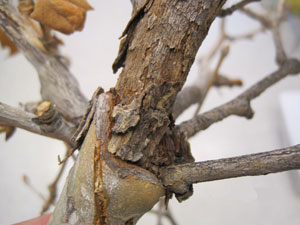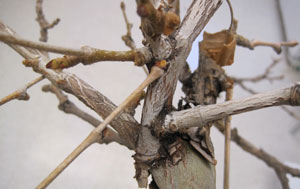by C.E. Swift* (12/14)
Quick Facts…
- The most serious disease of sycamore trees is anthracnose.
- Anthracnose often is confused with frost damage.
- The first symptoms appear on young leaves as they unfold.
- Older leaves turn brown, and dead areas occur along the leaf veins. Brown areas eventually enlarge to include the whole leaf.
- The ends of twigs may be killed back 8 to 10 inches.
- Cankers may develop on the tree trunk and main branches.
Anthracnose is the common name given to a group of fungal pathogens which cause dark, usually sunken lesions. The term anthracnose is from the Greek word for coal or charcoal. These are typically diseases of leaves, stems or fruits. The sycamore anthracnose fungal organism attacks sycamore trees early in the spring causing a rapid wilt of newly emerging leaves. This rapid wilting is frequently misidentified as frost damage. Larger, more mature leaves develop a brown growth along the main veins. Infected leaves often curl and eventually fall, littering the ground. The fungus involved is Apiognomonia errabunda & veneta (synonyms = Gnomonia errabunda & veneta); anamorphs = Discula umbrinella & platani.
The sycamore leaf is naturally fuzzy. Do not confuse this natural fuzziness with infection by anthracnose fungus.
Cankers
Cankers often form on the twigs and branches at the base of blighted leaf clusters. Cankers restrict water and nutrient movement to the leaves resulting in twig die-back, chlorosis and scorch on leaves, and even kill larger branches. These cankers are active during wet cool springs and produce spores that spread to neighboring twigs, leaves, and other sycamore trees.
Cankers also develop in larger branches, girdling and eventually killing them. Small, black fruiting bodies of the causal fungus appear in the discolored bark of dead twigs and branches.
Repeated annual killing of twigs results in clusters of old dead twigs and live branches creating what are called “witches’ brooms.”
Weather Influences
 Figure 1: This sunken dead area (canker) is due to Anthracnose. |
 Figure 2: The ‘witches broom’ is where numerous shoots grow from the same point. |
 Figure 3: This canker has several fruiting bodies poking through the dead tissue. |
 Figure 4: Note the pimple-like structures, fruiting bodies, on this stem. |
Weather determines the severity of anthracnose. Frequent rains and cool temperatures promote the disease. If the average temperature during the two-week period following emergence of the first leaves is below 55 degrees F, the shoot-blight phase of the disease will be serious.
Disease intensity decreases as the average temperature increases from 55 to 60 degrees. Little or no anthracnose will occur if average temperatures during this susceptible stage are above 60 degrees.
Treatment
Apply sprays as buds begin to swell. During rainy springs additional applications are needed at 7 to 14 day intervals until conditions for this disease are no long favorable (see Weather Influences above).
A second crop of leaves may be produced from mid-June into July after loss of the first set. Protect this second set of leaves with fungicide sprays if cool, moist conditions exist.
Fungicides registered for the control of sycamore anthracnose include chlorothalonil (Daconil Zn, Daconil Ultrex and Daconil Weather Stik. REI = 12 hours), thiophantemethyl (3336™ F and 3336™ WP. REI = 12 hours), and copper fungicides. Champion WP® and C-O-C-S® are copper fungicides approved for organic use. REI = restrictedentry interval. Do not enter or allow workers entry into treated areas during this period following fungicide application. The REI varies with the copper product. Refer to labels for specific information.
The recommended fungicides usually are readily available to homeowners at local nurseries and garden centers. Always read label directions. Labels may be updated yearly or more often. If the product label does not include anthracnose on ornamentals (shade trees), use an alternative product.
Cultural Practices
Gather and destroy all fallen leaves and twigs. They will produce fungus spores the following spring if not destroyed.
Prune out all infected twigs and branches and destroy them. Cut out cankers in large limbs to reduce reinfection. Remove the dead, cankered tissue down to healthy wood.
Dry winters weaken trees, increasing the effects of diseases. To reduce this problem, water trees once a month during snowless winters. Water when air temperatures are above freezing and early enough during the day to allow water to soak in before nightfall. For more information on winter watering, see fact sheet 7.211, Fall and Winter Watering.
In the spring after leaf emergence, apply nitrogen around trees suffering from repeated attacks of anthracnose. This nitrogen application should be based on a soil test (see Homeowner’s Guide to Fertilizing Your Lawn and Garden). A yearly application of nitrogen will stimulate growth and help anthracnose-infected trees recover from loss of leaves, twigs and branches.
Resistance
The American sycamore (Platanus occidentalis L) is much more susceptible to anthracnose than the London (Platanus x acerifolia) and Oriental plane (Platanus orientalis). Due to this high susceptibility, planting of the American sycamore should be avoided. The Oriental plane, a shorter, less graceful tree, is highly resistant to anthracnose but rarely grown in the United States. The London plane tree (P. x acerifolia, synonyms P. x orientalis or P. hybrida) is a cross between the Oriental plane (P. orientalis) and the highly susceptible American sycamore (P. occidentalis). The London plane cultivars, ‘Bloodgood’, ‘Columbia’ and ‘Liberty’ are resistant to anthracnose and are good choices for planting where the sycamore anthracnose fungus is a problem.
References
Dickman, M.B. 2001. Anthracnose. Page 43, in: Maloy, O.C., and Murray, T.D. eds. Encyclopedia of Plant Pathology, John Wiley & Sons, Inc., New York, NY.
Hartman, J. 2001. Sycamore and planetree diseases. Pages 355-359, in: Jones, R.K. and Benson D.M. eds. Diseases of Woody Ornamental and Trees in Nurseries. APS Press, St. Paul, MN.
Sinclair, W.A., Lyon, H.H., and Johnson, W.T. 1987. Diseases of Trees and Shrubs. Cornell University Press, Ithaca, NY. 574 pages.
Influence of Environment and Inoculum Density on Penetration and Colonization of Sycamore Leaves by Apiognomonia veneta. Ammon, V., Graves, B. and Griffin, D. Plan Dis. 74:989-991.
* C.E. Swift, Colorado State University Extension horticulture agent emeritus. 12/01. Revised 12/14.
Colorado State University, U.S. Department of Agriculture and Colorado counties cooperating. CSU Extension programs are available to all without discrimination. No endorsement of products mentioned is intended nor is criticism implied of products not mentioned.
Go to top of this page.





